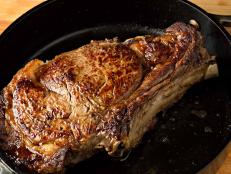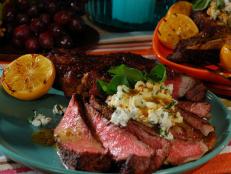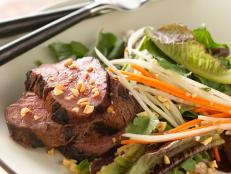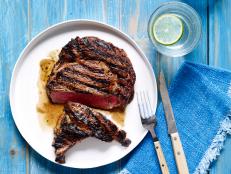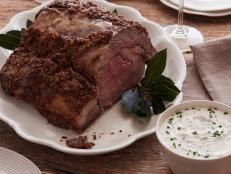Beef Buying Guide
Whether it's for the backyard or the kitchen, this guide will help you find the perfect cut of meat.
In addition to selecting your cut of meat at the grocery store or butcher, you might also find yourself faced with the task of determining if you want grass-fed or grain-finished, organic or natural. Here is what these labels mean:
Grass-fed, Organic and Natural
Grain-finished
Cattle are raised on grass for the first six months, but then fattened on grain (usually corn or soybeans) in the months before slaughter. Grain-fed cattle will gain weight much more quickly and with more marbling than those eating grass. This is the beef that Americans are most familiar with; about 85 percent of all beef sold is in this category. If the label does not specify grass-fed, you can assume the cow was grain-finished.
Grass-fed
Grass-fed refers to cattle raised, but not always exclusively, on grass and hay. Cows' stomachs easily digest grass (but not grain), so it is a more natural, humane and antibiotic-free way to raise cattle. Grass-fed beef is leaner, though not necessarily tougher, than grain-fed. There is a slight difference in flavor as some say it's a little gamier. Because it's leaner, it's best to cook grass-fed beef no more than medium-done. Nutritionally, it's higher in the healthy omega 3 fats, vitamin E and beta carotene. There are currently no regulations governing the use of the term; grass-fed claims are not subject to inspection and should not be confused with "'organic" beef (see Organic below).
Organic
Organic is a legally defined term, subject to strict rules and regular inspections. Meat labeled "organic" must be produced without synthetic fertilizer, antibiotics, hormones, pesticides, genetically modified ingredients or irradiation. Although organic cattle must have access to pasture, "organic" does not mean the animals were grass-fed or pasture-raised. Cattle raised organically can be fed grain as long as it is organically grown. Because organic rules forbid the feeding of animal byproducts to other animals, organic meats pose the lowest risk of mad cow disease.
Natural
The USDA allows producers of conventionally raised animals to use the label "natural" so long as their product contains no artificial flavor or color, chemical preservative or any other artificial ingredient. However, by the USDA's own definition, all fresh meat qualifies as "natural." Although much natural beef is raised with sustainable farming practices, there is no certification or inspection; compliance is on the honor system.
Pastured
Not applied to beef. The pastured label is permitted for pork and poultry products when the animals have been raised on pasture. Not quite the same thing as "grass-fed"; swine and poultry are omnivores and therefore cannot live on grass alone.
Free-range
The term is used exclusively for poultry, meaning the birds are not in cages.
Dry-Aging vs. Wet-Aging
You've heard of aged beef, but what is it and why would you want it? Aging, either dry or wet, simply refers to the slow enzymatic breakdown of proteins in the muscle. Done under strictly controlled conditions, it tenderizes the meat and develops flavor.
- Dry-aging is done at 34 to 36 degrees Fahrenheit, usually for 4 to 6 weeks. These are the slabs of beef you see hanging in high-end butchers' (refrigerated) windows. It's a costly process, reserved for only the finest cuts. Since it loses about 20 percent of its original weight to evaporation, the flavor is dramatically concentrated.
- Though the same chemical process is at work in wet-aging, the flavor compounds produced are very different. Wet-aging simply means the meat has been kept in its plastic wrap for an extra period of time (days or weeks). The wrap protects the meat from microbial growth while the enzymes do their thing. If you've ever kept meat in the fridge for a couple of days before cooking it, you were doing some informal wet-aging of your own.






















